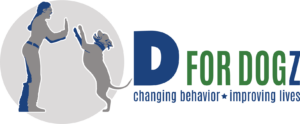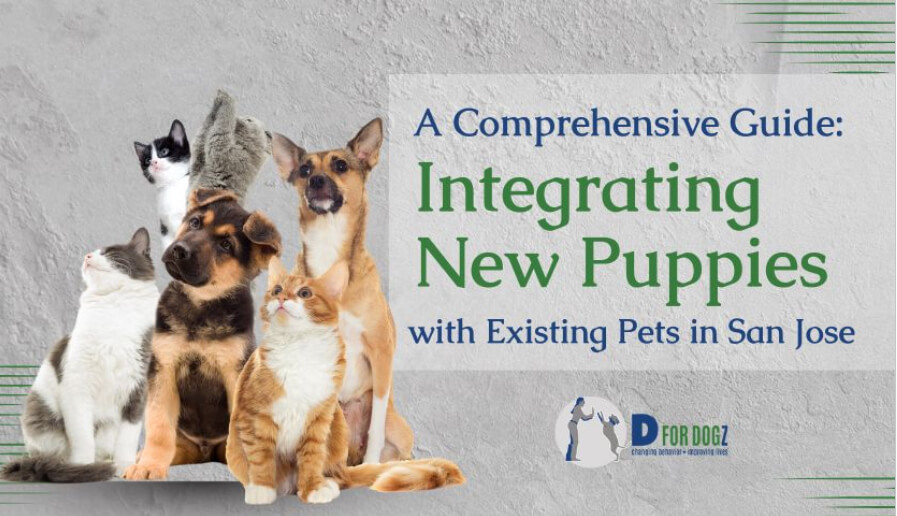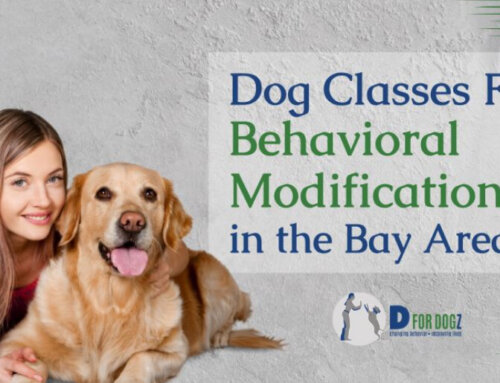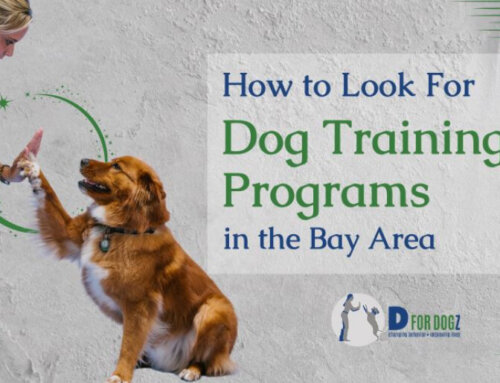Bringing a new puppy into your home is a joyful and exciting moment, yet it presents unique challenges, especially when you already have pets. Integrating a new puppy with your existing pets is crucial for the harmony and well-being of your household. Failure to integrate properly can lead to long-term behavioral issues, stress for both the pets and the owners, and, in some cases, aggressive confrontations.
Like those everywhere, San Jose dog owners face the challenge of ensuring their new addition and their current pets can coexist peacefully and form lasting bonds.
In the following guide, we’ll explore strategies to address these challenges, offering practical advice to help your new puppy and existing pets adjust to one another in a healthy, positive way. A thoughtful and informed approach can minimize stress and encourage a bond that enriches your family’s life.
Key Takeaways
- Prepare your home with crates and baby gates to create safe zones and controlled introductions.
- Conduct the first meeting in a neutral environment and use parallel walking to minimize stress and territorial behaviors.
- Manage food and toys by establishing separate feeding areas and removing competitive items to prevent conflicts.
- Seek professional help from D for Dog Training for personalized guidance and support if challenges persist.
Prepare Your Home
Preparing your home for the introduction of a new puppy to existing pets is a critical step to ensure a smooth and stress-free integration for all. The goal is to create a safe and welcoming environment that minimizes anxiety and prevents potential conflicts. Here’s how you can achieve this:

Image Source: Freepik
Crate and Baby Gates
Utilize These Tools for Controlled Introductions
Crates and baby gates are invaluable tools when introducing a new puppy to your home, especially when you have existing pets. They serve several important purposes:
- Create Safe Zones: Designate specific areas of your home where each pet can retreat and feel secure. This is especially important in the early stages of introduction when pets are still getting used to each other’s presence. A crate for the new puppy can serve as a haven where it can relax without feeling threatened by the resident pets. Similarly, baby gates can help manage your pets’ spaces, preventing unwanted interactions when you’re not there to supervise.
- Controlled Introductions: Use baby gates to allow your pets to see, smell, and interact with each other without the risk of a full-on encounter. Enabling them to get acquainted over time can help reduce anxiety and aggression.
- Illustration Instruction: Place the crate in a common area during the day where the new puppy and existing pets can see each other. During these times, ensure that interactions are supervised. Baby gates can section off parts of the house, like the living room or kitchen, providing a clear boundary while allowing visibility and scent exchange.
Separate Belongings
Assign Separate Areas for New and Existing Pets’ Items
Resource guarding can be a significant issue when introducing a new pet to your home. To prevent potential conflicts over toys, beds, and food bowls, it’s essential to assign separate areas for the belongings of your new puppy and existing pets.
- Designated Areas: Specific spots in your home for each pet’s belongings. For example, place the new puppy’s bed and toys in one corner and your existing pet’s in another. This helps establish a sense of ownership and reduces the likelihood of territorial behavior.
- Feeding Time Protocol: Feed your pets in different areas or rooms to prevent food aggression. If possible, maintain a feeding schedule where they eat simultaneously but not in direct view of each other to reduce tension.
- Example: If you have a dog introducing a new puppy, you might place the older dog’s food bowl in the kitchen and the puppy’s in the hallway or another room nearby. Ensure that each pet has its own set of toys, and consider gradually introducing new toys in a neutral space to see how they react to sharing.
By preparing your home, you’re setting the stage for a more successful integration of your new puppy with your existing pets. Remember, patience and gradual introductions are key to fostering a harmonious relationship.
Initial Meeting Strategies
When introducing a new puppy to your existing pets, the initial meeting is critical to set the tone for their future relationship. It’s important to approach this introduction thoughtfully, using strategies to minimize stress and territorial behavior. Two effective strategies are the Neutral Ground Introduction and Parallel Walking.
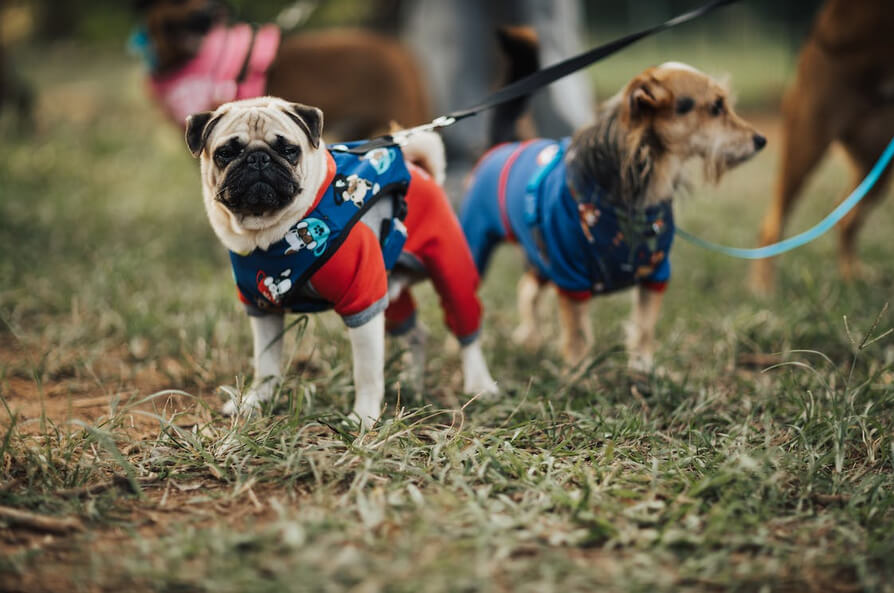
Image Source: Pexels
Neutral Ground Introduction
Conduct the First Meeting in a Park
Choosing a neutral location, such as a park, for the first meeting between your new puppy and existing pets can significantly reduce potential territorial behavior. A neutral ground ensures neither pet needs to defend its space, allowing for a more relaxed and natural interaction.
- Benefits: Neutral territories don’t hold the scent markers of your existing pets, which can help prevent defensive or aggressive responses. They also create a level playing field where both pets can explore and interact without the added pressure of territory.
- How to Execute: Bring both pets to the park separately, accompanied by different family members or friends. At first, allow them to observe each other from a distance, gradually decreasing the space between them. This gradual introduction helps prevent overwhelming either animal and will enable you to gauge their reactions to each other.
Parallel Walking
Start with Parallel Walking at a Distance
Parallel walking is an excellent follow-up to the neutral ground introduction. It involves walking both pets on leashes, side by side, but at a safe distance that prevents confrontation. This method allows pets to become accustomed to each other’s presence non-threateningly.
- Benefits: This approach helps both animals to acclimate to each other’s presence and movements without the immediate need for face-to-face interaction. It’s a form of indirect communication that can be less stressful for pets, especially in the early stages of acquaintance.
- Implementation: Start with a significant gap between the pets, gradually reducing the distance as they become more comfortable with each other. Keeping the leashes loose is essential to avoid creating tension that the pets might sense. Choose a quiet, distraction-free route if possible, and be mindful of each pet’s body language, ready to increase the distance if any signs of discomfort or aggression are observed.
Incorporating these initial meeting strategies can significantly enhance the chances of a positive relationship between your new puppy and existing pets. It’s crucial to remain patient and observant throughout the process, ready to adjust your approach based on the pets’ reactions and comfort levels.
Home Introduction
Once you’ve successfully facilitated an initial meeting in a neutral environment and observed positive interactions between your new puppy and existing pets, the next step is to introduce them within the confines of your home. This phase requires careful planning and oversight to ensure a smooth transition and to foster a positive relationship within your living space.
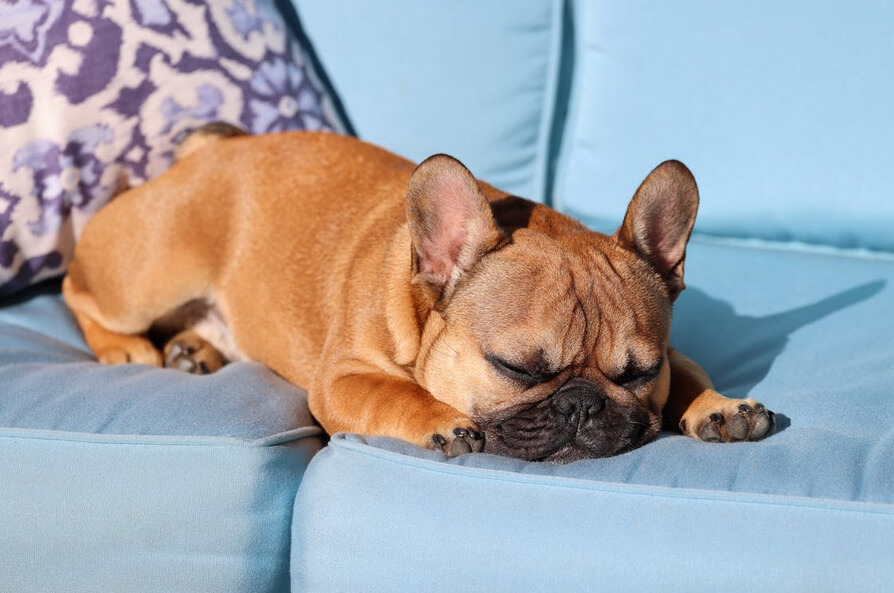
Image Source: Pexels
Controlled Environment
Starting with Outdoor Spaces
Introducing your pets in a controlled environment, particularly starting in the outdoor spaces of your home, such as a backyard, can serve as an intermediate step before indoor cohabitation. This method helps maintain the neutral territory feel and eases the transition to indoor spaces.
- Benefits: Outdoor spaces often provide more room to move, reducing the chances of immediate territorial disputes and allowing for natural exploration and interaction under less restrictive conditions.
- Execution: After arriving home from neutral ground, allow both the new puppy and existing pets to explore the outdoor area together. This should still be done under close supervision. They might be more inclined to play or interact positively in this familiar yet open setting if the initial meeting went well.
Supervised Interaction
Closely Monitor and Gradually Increase The Time
As your pets become more comfortable with each other’s presence outdoors, you can begin to introduce them to indoor spaces. These interactions must remain closely supervised, especially in the early stages.
- Step-by-Step Supervision: Start with short, supervised periods of interaction in controlled sections of your house. Use baby gates to limit access to parts of the house if necessary. This allows pets to get used to sharing space without becoming overwhelmed.
- Gradual Increase in Interaction Time: As your pets show signs of comfort and friendliness towards each other, gradually increase the time they spend together. This could mean allowing them to share the same space under your watch for extended periods or even without separating baby gates, provided you are confident in their ability to coexist peacefully.
- Continued Monitoring: Even as your pets grow more accustomed to each other, it’s important to continue monitoring their interactions. Look for signs of stress or aggression and be prepared to intervene if necessary. Remember, the goal is to ensure a safe and positive environment for all your pets.
By carefully managing the home introduction phase, leveraging controlled environments, and ensuring supervised interactions, you can significantly increase the likelihood of a harmonious relationship between your new puppy and existing pets. Patience, observation, and gradual adjustment are key components of this process, aiming to create a stable and happy home for all your furry family members.
Managing Food and Toys
Creating a harmonious environment when integrating a new puppy with existing pets involves more than just facilitating friendly meetings; it also requires managing potential sources of conflict like food and toys. Ensuring your pets are comfortable and not competing over resources is crucial to preventing stress and aggression.
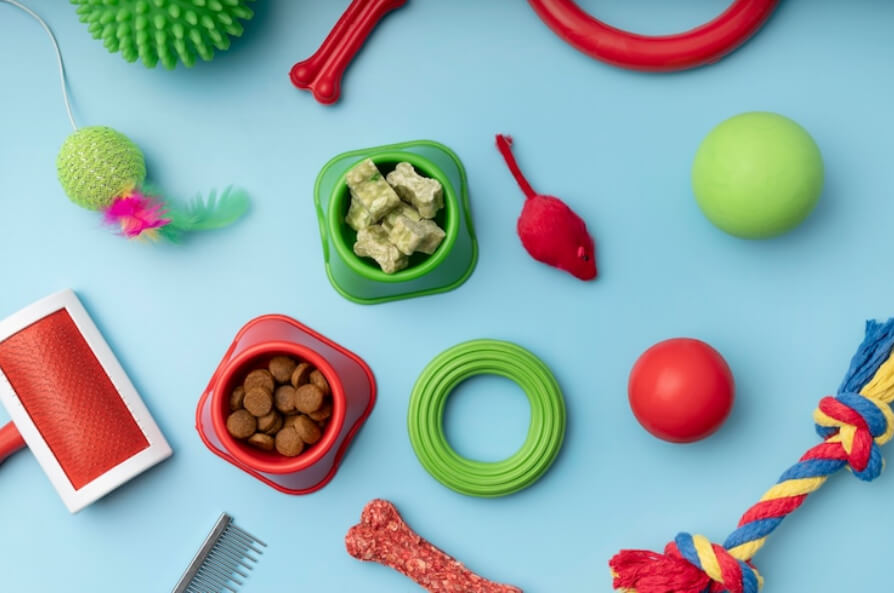
Image Source: Freepik
Separate Feeding Areas
Feed Pets in Different Areas
Competition over food is one of the most common triggers for conflict among pets. Establish separate feeding areas for your new puppy and existing pets to mitigate this.
- Implementation: Choose distinct spaces in your home where each pet will be fed, away from each other. This could mean feeding them in different rooms or at opposite ends of the same room, as long as they have their space. The goal is to make each pet feel secure during meal times without guarding their food from others.
- Routine: Maintain a consistent feeding schedule to help establish a routine. This predictability helps reduce anxiety around meal times and reinforces the understanding that competing for food is unnecessary.
Remove Competitive Items
Eliminate Toys or Other Items That Could Cause Rivalry
Food, toys, and other high-value items can also be sources of rivalry among pets, especially during the initial introduction period.
- Selective Availability: During the early stages of your pets getting to know each other, be mindful of which toys are available to them when they are together. It might be wise to temporarily remove high-value toys that could lead to possessiveness or competition.
- Observation and Introduction: Watch how your pets interact with common toys. Gradually introduce toys they can play with, encouraging shared playtime and interaction under supervision. This can help build a positive association between the pets.
- Positive Reinforcement: Use treats and praise to encourage your pets when they play nicely together or respect each other’s space. This positive reinforcement helps build a friendly relationship between your new puppy and existing pets.
Managing food and toys carefully contributes to a peaceful and joyous integration process. You can help your pets feel safe, secure, and happy in their shared home by preventing competition and reinforcing good behavior.
Professional Help
Even with diligent preparation and careful management of interactions, integrating a new puppy with existing pets can sometimes present challenges that are difficult to overcome on your own. In some cases, behaviors like excessive aggression, anxiety, or resource guarding might not resolve with time and patience alone. This is where professional help can make a significant difference.

When to Consult a Trainer
Recognizing when to seek the assistance of a professional dog trainer or behaviorist is crucial for the well-being of your pets and the harmony of your home. Here are some indicators that professional guidance might be needed:
- Persistent Aggression or Fear: If, despite your best efforts, one or more of your pets continue to display signs of aggression, fear, or anxiety around each other, it may be time to consult a professional. These behaviors can escalate if not adequately addressed.
- Resource Guarding: While it’s natural for dogs to want to protect their food or toys, excessive guarding can lead to conflicts. A professional can provide strategies to manage and reduce these behaviors.
- Difficulty Establishing a Hierarchy: Sometimes, pets struggle to establish a peaceful hierarchy on their own. A trainer can help facilitate this process, ensuring that each pet understands their role within the family.
How D for Dog Training Can Help
D for Dog Training offers professional dog training services tailored to meet your family and pets’ unique needs. With a focus on positive reinforcement and a deep understanding of animal behavior, their experienced trainers can provide the support and guidance necessary to address the challenges you may face during the integration process.
- Tailored Guidance: D for Dog Training assesses your household’s specific dynamics to provide personalized solutions that promote harmony and reduce conflict.
- Behavioral Modification: Their experts specialize in behavioral modification, offering strategies to address and correct problematic behaviors.
- Support and Resources: Beyond one-on-one training sessions, D for Dog Training provides ongoing support to ensure you feel confident and equipped to manage your pets’ interactions effectively.

Seeking professional help from a reputable service like D for Dog Training can be a game-changer in achieving a peaceful, happy home for your new puppy and existing pets. With the right support, even the most challenging situations can be transformed into positive outcomes, ensuring that all your pets coexist harmoniously.
Conclusion
Integrating a new puppy into a household with existing pets in San Jose requires careful planning, patience, and a strategic approach. By preparing your home, facilitating careful initial meetings, and effectively managing resources like food and toys, you can lay the foundation for a harmonious and stress-free integration.
Remember, challenges may arise, but with the support of professionals like D for Dog Training, even the most daunting situations can be navigated successfully. By following these guidelines, you can help ensure a smooth transition for your new puppy while maintaining the well-being and happiness of your existing pets.
Are you eager to see your puppy thrive among friends? Discover the joy and benefits of D for Dog Training’s Puppy Socials in the Bay Area! Our specially designed socials are the perfect place for your furry friend to learn essential social skills, engage in playful interactions, and start their path to becoming a friendly, confident dog. Don’t let your puppy miss out on the fun and learning—sign up today and be part of a community that values positive puppy development!
About the Author: Kaajal Tiwary
Kaajal (aka “KT”!) loves puppies and is dedicated to getting new puppy guardians off on the right paw and guiding her students through the tough early days of owning a dog. Her goal? Transforming each bundle of raw puppy energy into the perfect adult companion.
